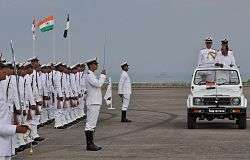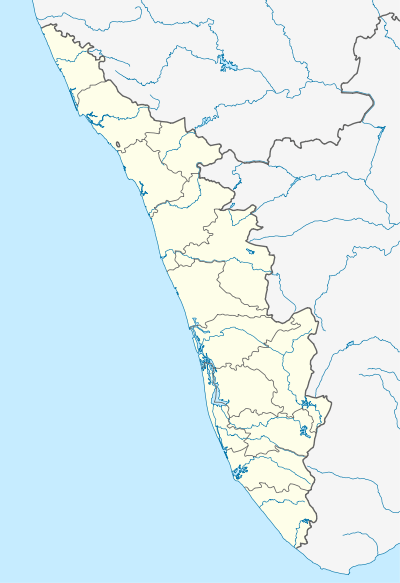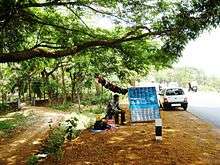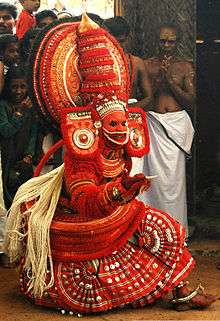Payyanur

| Payyanur പയ്യന്നൂര് | |
|---|---|
| City | |
|
| |
 Payyanur  Payyanur Location in Kerala, India | |
| Coordinates: 12°06′27″N 75°11′40″E / 12.1076100°N 75.1943590°ECoordinates: 12°06′27″N 75°11′40″E / 12.1076100°N 75.1943590°E | |
| State | Kerala |
| District | Kannur |
| Taluk | Payyanur |
| Population (2001) | |
| • Total | 68,711 |
| • Density | 72/km2 (190/sq mi) |
| Languages | |
| • Official | Malayalam |
| Time zone | IST (UTC+5:30) |
| PIN | 670307 |
| Telephone code | +91 4985 |
| ISO 3166 code | IN-KL |
| Vehicle registration | KL-13 & KL-59 |
| Nearest cities | Taliparamba, Kannur |
| Sex ratio | M:F - 48:52 ♂/♀ |
| Literacy | 99.3% |
| Lok Sabha constituency | Kasaragod |

Payyanur is a city in Kannur district of Kerala at the northern part, North Malabar region, state of Kerala, India. This municipality consists of three administrative villages: Vellur, Korom and Payyanur. Other villages are: Annur and Kokkanissery.[1] The City is situated on the banks of Perumba River.
Demographics
As of 2001 India census,[2] Payyanur had a population of 68,711. Males constitute 48% of the population and females 52%. Payyanur has an average literacy rate of 83%, higher than the national average of 59.5%: male literacy is 86%, and female literacy is 80%. In Payyanur, 10% of the population is under 6 years of age.
Etymology
The place derives its name from the renowned Sri Subrahmanya Swami Temple located here. Payyan is an appellation of Lord Subrahmanya and ooru means "the place". Thus Payyanur means the land of Lord Subrahmanya. Payyanur is also well known for astrology, Pavithra Mothiram, art forms like Theyyam and Poorakkali, and historical movements at the time of freedom struggle. It is considered as the world hub of astrology sometimes.[3]
Geography
Payyanur is located at 12°06′N 75°12′E / 12.1°N 75.2°E.[4] It has an average elevation of 16 metres (51 feet).
History
Payyanur is one of extant ancient civilized places in Kerala.[1] This northern town of Kerala claims a rich and glorious recorded history. The archeological remains excavated from Payyanur and nearby places prove the existence of a city in this area centuries ago.[1]
The earliest known mention of this town is in the Brahmanda Purana, when Garga Muni talks about this place to the Pandavas, during their exile.[5]
The famous travellers, who visited here, have described about this area with high praise. The famous traveler Ibn Bathutha visited Ezhimala in AD 1342 and wrote about the large seaport and the Chinese ships anchored here. In AD 1273, Abul Fida, and in AD 1293, the world-famous traveler, Marco Polo, and in the 15th century, the Italian traveler Nicholo Konti all visited this place, and have given good and extensive accounts of Ezhimala port, which known by the name of “Heli”. The Portuguese Scholar and traveler Barbosa had also described this place.[1]
Centuries back, Payyanur was a part of the Ezhimala/Mushika/Kolathiri Kingdom. King Nandan who ruled this Kingdom was mighty and well known as a great warrior and ruler. The books written during the Sangam period describe about this country and this King with much importance. At certain times, Ezhimala was also under the rule of the Cheras.
Evolution of Payyanur Town

During the past the city centre was Kachil Patanam (present Kavvayi) was the main town because of the waterways through Kavvayi River and its big Seaport. It was the administrative as well as business centre during that time. According to historians ships from China and other countries used to visit this port and anchored in the nearby river Changoorichal. Kavvayi retained its position even during the rule of British East India Company also. They established the first Magistrate's court and Registrar’s Office in Kavvayi only.
Later Kokkanisseri became the city centre. The main road, which starts from Perumba, divided the town into two. The south of this road was called Payyanur village and the north Kokkanisseri village. The business centre was called Kokkanisseri Bazaar. Later the name Payyanur became common and thus the developed city of today came into existence.

During the regime of the Kolathiri Dynasty, Payyanur was a part of Kolathu Nadu ruled by the Kolathiri Rajas based in Chirakkal near Kannur. During the British Rule, Payyanur was considered as a "farka" which in term is a part of the Chirakkal Taluk. Till the formation of the Kerala State in 1957, Payyanur remained in the Malabar District of the Madras State. The famous scholar and author Dr. Hermann Gundert, William Logan, the Malabar District collector during the British Rule who wrote Malabar Manual also visited Payyanur and did a lot of studies on the rich heritage of Payyanur.
Education
Colleges in Payyanur:
- Payyanur College, Edat.
- Gurudev Arts & Science College, Mathil
- College of Engineering and Technology, Mathamangalam.
- Residential womens polytechnic college payyannur.
- Govt ITI Peringome,Peringome
- Govt College Peringome
Social Service
Payyanur has groomed several social workers like Peeranki Nambeesan, community activists, extraordinary orator and freedom fighter KP Kunhirama Poduval who founded Sanjayan Smaraka Grandhalayam at Annur (Sanjayan Memorial Library), Kelappan Service Center (perhaps the only institution built in memory of Kelappaji, also known as "Kerala Gandhi") and Payyanur Co-operative Stores among a host of other social organizations. Also from Payyanur are: Subrahmanya Shenoy (communist ex-MLA),V.P Sreekandha poduval(freedom fighter and "vayider").
Culture
'Theyyam' and religious festivals (Kaliyattam) of various temples in and around will be attraction of Payyanur. Poorakkali & kolkali are the major traditional dance ritual performance.Architect Kunhimangalam Narayanan master . V.P.Dhananjayan, the world-renowned dancer, Appukkuttan master, and Dr E.Sreedharan, the Sanskrit scholar. The native place of legendary Kathakali master Kalamandalam Krishnan Nair isn't far from this town. Kandoth in Payyanur is famous for pottery.The Weaver's Streets of various villages around Payyanur contributes to the fame of Handlooms of Kannur.

The Mangrove Trail of Malabar - Payyanur
.jpg)
The Mangrove Trail of Malabar is a coastal Jungle trail in North Kerala located at Payyanur in Kannur district offering close-up views of aquatic, plant and bird life. The main attraction of the Mangrove trail is the Mangrove ecosystem and the breathtaking landscape dominated by tidal creeks and waterways. This inter tidal ecosystem in Kerala, loosely described as the Mangrove Trail of Malabar is inhabited by a variety of fish, shrimps, crabs, mudskippers and some of the most sought after birds in the world. An encounter with a brown-winged Kingfisher, Grey headed Lapwing, Pallas's Fish Eagle, Lesser Adjutant or maybe Mangrove Whistler is always a possibility at the Mangrove trail of Malabar. The popular sights are Myna, Quails, Kingfisher and Wildfowl’s. Migratory birds like the Siberian cranes are sighted during the rainy season in Kerala. If luck favours, one may also come across Sea Turtles & Otters. The Mangrove Trail of Malabar is also a home to Mountain Squirrels, Jackals and a variety of reptiles. With a unique ecosystem of two high tides and two low tides each day, this terrain is tough to negotiate. The muddy swamps of the Mangrove trail add ruggedness to the journey and boating in the creeks is an unforgettable experience for the discerning traveller visiting Kerala. This place is a day tripper’s paradise and a wonderland for photographers. The tour inside the trail takes about an hour and a half. This venture promotes Ecotourism in Kerala and our aim is to conserve Mangroves. The local community has been employed in the Mangrove Trail and has been roped in as guides and oarsmen who also oversee the conservation of the Mangroves. At present there is no accommodation facility in the Mangrove Trail and visits can be arranged by advance reservation through telephone or email. Malabar Ecotourism welcomes you to an experience that is the best kept secret of Kerala.
Pavithra Mothiram
Payyanur Pavithram or Pavithra Mothiram is internationally famous like" Aranmula Mirror "or "Ambalapuzha Palpayasam". Pavithram is the particular ring worn during performing vedic or holy rituals or during the "pithrubali" (ceremony performed for the well-being of the forefathers or departed souls) in the Hindu tradition. The traditional Pavitram is usually made of "dharba" grass. The formation of Payyanur Pavitram is closely related with Payyanur Sree Subrahmanya Swami Temple. According to the legends, Pavitram made of gold was recommended to avoid the inconvenience of making it many times a day for the various poojas and rituals.[6]
Payyanur Pavithra Mothiram is a uniquely crafted ring shaped like a knot and considered being a sacred ornament. Usually, Payyanur Pavithram is being made of Gold and Silver. The Pavithram is to be worn on the right ring finger by the person performing Vedic Karmas. It is believed that this ring will bring luck and grace to anyone who wears it with the deep devotion. The three lines on the top of the ring represents the three vital "nadees"(nerves) of the human body, Ida, Pingala and Sushumna. The knot between these three nerves together can awake or arose the "Kundalini sakthi" (vital energy of the body) of the human body. It is believed that the Pavithram brings the "Trimoorthi Chaithanyam" ( the vigor or the effect due to the presence of the trinity of Brahma, Vishnu and Shiva).The person who wear Pavithram as well as the Goldsmith who makes it has to have to impose some sort of self-control or discipline over themselves. They should be pure vegetarian and shouldn't take alcohol and should keep way from immoral activities. If worn by women, they have to remove the ring during the period of menstruation.
According to tradition, the Pavithram, before handed over to the customer, is taken to Payyanur Perumal Temple for special poojas and a part of the cost of the ring will be given to the temple as an offering. Payyanur Pavithram is being exhibited in many of the museums of India as well as abroad. It is relevant to mention the name of late C.V. Kunhambu, who was an expert in the making of Payyanur Pavithram and was also a great freedom fighter. Payyanur has a great history of national movement, prominent leaders being, KP Kunhiraman Poduval and Subrahmanya Shenoy.
Astrology
Payyanur is famous for well known astrologers like VPK Poduval, Madhava Poduval, Narayana Poduval, Chinda poduval and young achievers like Sooraj Poduval, Chithrabhanu K Poduval.
See also
- Kandamkulangara
- Valiyaparamba Backwaters 15 km from Payyanur
- Indian Naval Academy 5 km from Payyanur Railway Station
- Ezhimala 12 km from Payyanur Town
- Kunhimangalam village 8 km from Payyanur town
- Kavvayi Island 3 km from Payyanur
- Prijesh Kannan, Guinness World Record Holder in Memory Power who resides in Payyanur
References
| Wikimedia Commons has media related to Payyanur. |
| Wikivoyage has a travel guide for Payyanur. |
- 1 2 3 4 "Payyanur Informations : Payyanur Municipality Profile".
|first1=missing|last1=in Authors list (help) - ↑ "Census of India 2001: Data from the 2001 Census, including cities, villages and towns (Provisional)". Census Commission of India. Archived from the original on 2004-06-16. Retrieved 2008-11-01.
- ↑ "Name Payyanur History : Payyanur Name History Profile".
|first1=missing|last1=in Authors list (help) - ↑ Falling Rain Genomics, Inc - Payyanur
- ↑ http://payyanur.com/subrahmanya.htm
- ↑ http://payyanurpavithram.com/influence/
